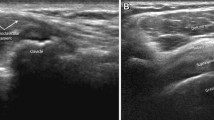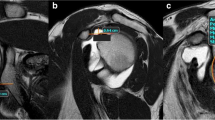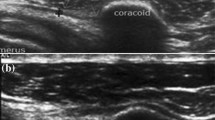Abstract
The purpose of this study was to investigate the value of ultrasonography in the pre-operative assessment of patients with recurrent post-traumatic, anterior shoulder instability. Forty-four consecutive patients, 44 men and 12 women, with unilateral, post-traumatic, recurrent instability of the shoulder were included in the study. One experienced radiologist examined all patients, using a 5.0 or 7.5 MHz linear-array transducer, with the arm in different positions, one of which was used to provoke apprehension of the shoulder. Special attention was paid to the evaluation of the joint capsule, the anterior labrum, especially in terms of the presence of a Bankart lesion. All patients were subsequently treated surgically. After a diagnostic arthroscopy either an open or arthroscopic stabilisation of the shoulder was performed. Ultrasonography disclosed an unstable anterior labrum (equivalent to a Bankart lesion) in 36 shoulders; the lesion was verified in all 36 shoulders during arthroscopy. In three shoulders, arthroscopy disclosed an injured labrum, which had healed in an anterio-medial position on the scapular neck. In these three shoulders, ultrasonography failed to show any lesion. In five shoulders no Bankart lesion was found at arthroscopy. All these patients had increased shoulder laxity, and ultrasonography did not show any Bankart lesion. Furthermore a judgement of the joint capsule was not possible either. A bony Bankart lesion was found in four shoulders, using both arthroscopy and ultrasonography. The sensitivity of the ultrasonographic evaluation was 92%, and the specificity 100%. The positive predictive value was 100%, and the negative predictive value 63%. Ultrasonography showed a high correlation with the arthroscopic findings, with a high sensitivity and specificity. Therefore, we conclude that US can give important pre-operative information in patients with recurrent, unilateral, post-traumatic, anterior shoulder instability.




Similar content being viewed by others
References
Hovelius L, Thorling J, Fredin H (1979) Recurrent anterior dislocation of the shoulder. Results after the Bankart and Putti-Platt operations. J Bone Joint Surg 61:566–569
Warner JJP, Warren RF (1991) Arthroscopic Bankart repair using a cannulated absorbable fixation device. Oper Techn Orthop 1:184–191
Burk DL, Karasick D, Kuntz AB (1989) Rotator cuff tears: prospective comparison of MR imaging with arthrography, sonography and surgery. Am J Roentgenol 153:87–92
Ziegler DW (2004) The use in-office, orthopaedist-performed ultrasound of the shoulder to evaluate and manage rotator cuff disorders. J Shoulder Elbow Surg 13:291–297
Wintzell G, Larsson H, Larsson S (1998) Indirect MR arthrography of anterior shoulder instability in the ABER and the apprehension test positions: a prospective comparative study of two different shoulder positions during MRI using intravenous gadodiamide contrast for enhancement of the joint fluid. Skeletal Radiol 27:488–494
Pancioni L, Gatti G, Mecozzi B (1997) Diagnosis of Hill–Sachs lesions of the shoulder: comparison between ultrasonography and arthro-CT. Acta Radiol 38:523–526
Altchek DW (1993) Shoulder instability in the throwing athlete. Sports Med Arthrosc Rev 1:210–216
Hammar MV, Wintzell GB, Åström KGO, Larsson S, Elvin A (2001) Role of US in the pre-operative evaluation of patients with anterior shoulder instability. Radiology 219:29–34
Sugimoto K (2004) Ultrasonographic evaluation of the Bankart lesion. J Shoulder Elbow Surg 13:286–290
Karlsson J, Magnusson L, Ejerhed L, Hultenheim I, Lundin O, Kartus J (2001) Comparison of open and arthroscopic stabilization for recurrent shoulder dislocation in patients with Bankart lesion. Am J Sports Med 29:538–542
Mack LA, Matsen FA III, Kilcoyne RF, Davies PK, Sickler ME (1985) US-evaluation of the rotator cuff. Radiology 157:205–209
Hodler J, Fretz CJ, Terrier F, Gerber C (1988) Rotator cuff tears: correlation of sonographic and surgical findings. Radiology 169:791–794
Farin PU, Jaroma H (1995) Acute traumatic tears of the rotator cuff: value of sonography. Radiology 197:269–273
van Holsbeck MT, Kolowich PA, Eyler WR (1995) US depiction of partial-thickness tear of the rotator cuff. Radiology 197:443–446
Alasaarela E, Leppilahti J, Hakala M (1998) Ultrasound and operative evaluation of arthritic shoulder joints. Ann Rheum Dis 57:357–360
Brandt TD, Cardone BW, Grant TH, Post M, Weiss CA (1989) Rotator cuff sonography: a reassessment. Radiology 173:323–327
Drakeford MK, Quinn MJ, Simpson SL, Pettine KA (1990) A comparative study of ultrasonography and arthrography in evaluation of the rotator cuff. Clin Orthop 253:118–122
Kartus J, Ejerhed L, Funck E, Köhler K, Sernert N, Karlsson J (1998) Arthroscopic and open shoulder stabilization using absorbable implants. A clinical and radiological comparison of two methods. Knee Surg Sports Traumatol Arthrosc 6:181–188
Crass JR, Craig EV, Thompson RC, Feinberg SB (1984) Ultrasonography of the rotator cuf: surgical correlation. J Clin Ultrasound 12:487–492
Middleton WD, Edelstein G, Reinus WR, Melson GL, Murphy WA (1984) Ultrasonography of the rotator cuff: technique and normal anatomy. J Ultrasound Med 3:549–551
Roberts CS, Walker JA, Seligson D (2001) Diagnostic capabilities of shoulder ultrasonography in the detection of complete and partial rotator cuff tears. Am J Orthop 10:159–162
Sonnabend DH, Hughes JS, Giuffre BM, Farrell R (1997) The clinical role of shoulder ultrasound. Aust N Z J Surg 67:630–633
van Moppes FI, Veldkamp O, Roorda J (1995) Role of shoulder ultrasonography in the evaluation of the painful shoulder. Eur J Radiol 19:142–146
Wiener SN, Seitz WH (1993) Sonography of the shoulder in patients with tears of the rotator cuff: accuracy and value for selecting surgical options. Am J Roentgenol 160:103–107
Author information
Authors and Affiliations
Corresponding author
Rights and permissions
About this article
Cite this article
Magnusson, L., Kälebo, P., Baranto, A. et al. The value of ultrasonography in the preoperative diagnostic evaluation of patients with recurrent anterior shoulder dislocation: a prospective study of 44 patients. Knee Surg Sports Traumatol Arthrosc 15, 649–653 (2007). https://doi.org/10.1007/s00167-006-0225-4
Received:
Accepted:
Published:
Issue Date:
DOI: https://doi.org/10.1007/s00167-006-0225-4




